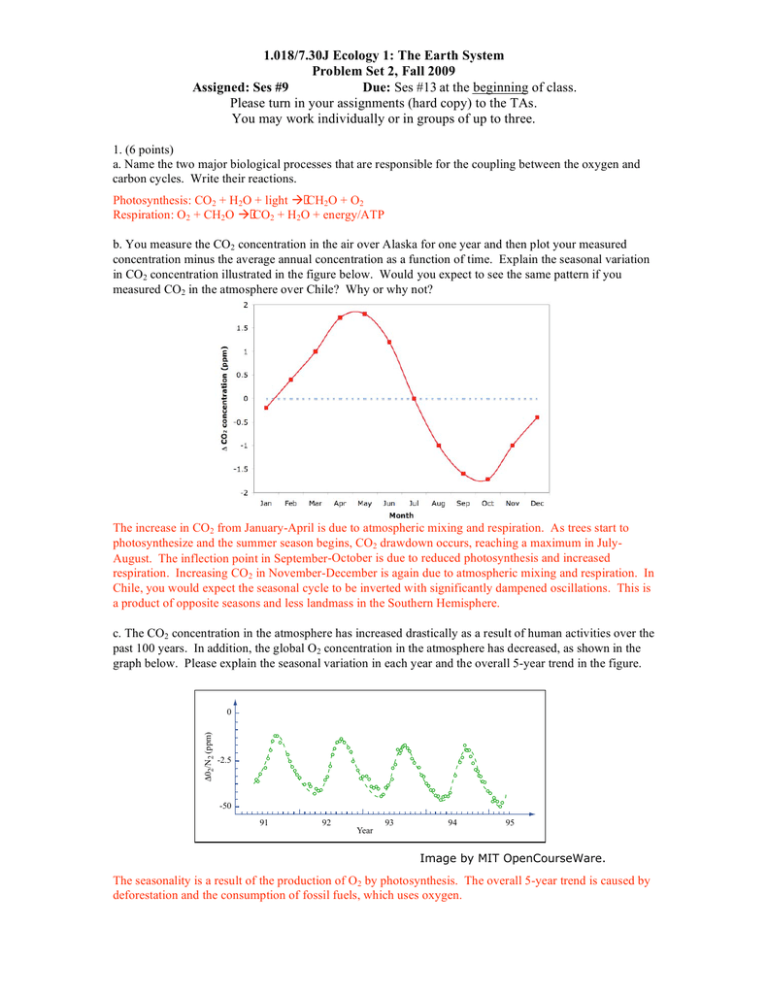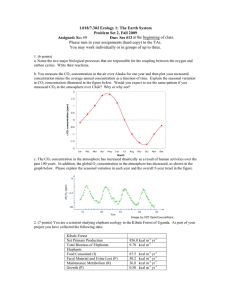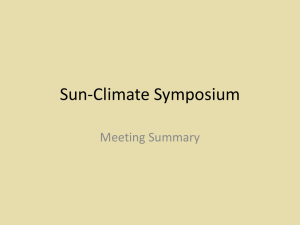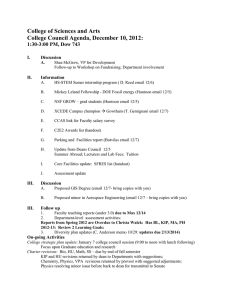Document 13497125
advertisement

1.018/7.30J Ecology 1: The Earth System Problem Set 2, Fall 2009 Assigned: Ses #9 Due: Ses #13 at the beginning of class. Please turn in your assignments (hard copy) to the TAs. You may work individually or in groups of up to three. 1. (6 points) a. Name the two major biological processes that are responsible for the coupling between the oxygen and carbon cycles. Write their reactions. Photosynthesis: CO2 + H2O + light CH2O + O2 Respiration: O2 + CH2O CO2 + H2O + energy/ATP b. You measure the CO2 concentration in the air over Alaska for one year and then plot your measured concentration minus the average annual concentration as a function of time. Explain the seasonal variation in CO2 concentration illustrated in the figure below. Would you expect to see the same pattern if you measured CO2 in the atmosphere over Chile? Why or why not? The increase in CO2 from January-April is due to atmospheric mixing and respiration. As trees start to photosynthesize and the summer season begins, CO2 drawdown occurs, reaching a maximum in JulyAugust. The inflection point in September-October is due to reduced photosynthesis and increased respiration. Increasing CO2 in November-December is again due to atmospheric mixing and respiration. In Chile, you would expect the seasonal cycle to be inverted with significantly dampened oscillations. This is a product of opposite seasons and less landmass in the Southern Hemisphere. c. The CO2 concentration in the atmosphere has increased drastically as a result of human activities over the past 100 years. In addition, the global O2 concentration in the atmosphere has decreased, as shown in the graph below. Please explain the seasonal variation in each year and the overall 5-year trend in the figure. ∆02/N2 (ppm) 0 -2.5 -50 91 92 Year 93 94 95 Image by MIT OpenCourseWare. The seasonality is a result of the production of O2 by photosynthesis. The overall 5-year trend is caused by deforestation and the consumption of fossil fuels, which uses oxygen. 2. (7 points) You are a scientist studying elephant ecology in the Kibale Forest of Uganda. As part of your project you have collected the following data: Kibale Forest Net Primary Production Total Biomass of Elephants Elephants Food Consumed (I) Fecal Material and Urine Lost (F) Maintenance Metabolism (R) Growth (P) 856.0 kcal m-2 yr-1 9.70 kcal m-2 67.5 30.2 36.8 0.50 kcal m-2 yr-1 kcal m-2 yr-1 kcal m-2 yr-1 kcal m-2 yr-1 a. What is the exploitation efficiency of the elephants? NPP is rate of plant biomass production C.E. = plants consumed / total plants produced = 67.5 / 856 = 0.079 = 7.9% b. What is the assimilation efficiency of the elephants? A.E. = An / In An = energy assimilated = energy ingested – energy lost in fecal material and urine = 67.5 – 30.2 = 37.3 In = food consumed = 67.5 A.E. = 37.3 / 67.5 = 0.55 = 55% c. What is the production efficiency of the elephants? Production of elephants = Pn = growth = 0.5 An = energy assimilated = energy ingested – energy lost in fecal material and urine = 67.5 – 30.2 = 37.3 P.E. = Pn / An = 0.5 / 37.3 = 0.0134 = 1.34% d. Below is an energy flow diagram for one elephant, Babar. Sketch the energy flow diagram of Babar if he was cold-blooded. P P R R A A F I F I 3. (7 points) The population dynamics of a natural pond system are dictated solely by the food web pictured below. Water milfoil (Myriophyllum) is an invasive Eurasian genus of aquatic plants found in North American lakes and ponds. Spirogyra is a form of filamentous green algae that are native to North American freshwater ecosystems. Trout Mosquito Larvae Snail Daphnia Milfoil Spirogyra a. In order to help save the native Spirogyra population, you have a few measures available to you. You can either adjust the trout population (by adding more trout or by encouraging more fishing) or you can adjust the mosquito larvae population (by adding more larvae or by applying a biocide that only kills mosquito larvae). Which measure would be most effective at increasing the population of Spirogyra? Why? Clearly state all assumptions. Increasing the population of mosquito larvae is the most direct method of increasing the population of Spirogyra. Increasing mosquito larvae will decrease the population of Daphnia, which feed exclusively on Spirogyra. There are a number of secondary effects that could be argued depending on the assumed time scale and response of populations. b. A golf course is built upstream of the pond. The fertilizers from the runoff cause a 50% increase in the primary productivity of both milfoil and Spirogyra. By how much would you expect the productivity of snails and Daphnia to increase? Assume the ecological efficiency at each trophic level is 10%. Show calculations and explain your reasoning. The productivity of snails and Daphnia will both increase by 50%. Assuming a trophic level transfer efficiency of 10%, we can project how the increase in productivity will cascade through the food web. P = total primary productivity before golf course and 1.5*P = total primary productivity after golf course Productivity of snails before golf course = 0.1*P Productivity of snails after golf course = 0.1*1.5*P % increase = 100*(0.1*1.5*P – 0.1*P)/(0.1*P) = 50% 4. (6 points) Al Gore has another idea for his new movie, More Inconvenient Truths. He wants you to assess the impacts of climate change on the hydrologic cycle. a. How is the hydrologic cycle expected to change over the next century? Be sure to note sources in your answer. Global warming is expected to accelerate the hydrologic cycle, effectively increasing global evapotranspiration and precipitation. Some snowfall will become rainfall. The melting of the snowpack and spring flood will occur earlier. Semiarid regions are expected to experience more droughts. Sea level rise will result in saltwater intrusion of coastal aquifers. b. Approximately 23% of the energy available at the Earth’s surface is used for evaporating water (either evaporation from free water surfaces or transpiration from plants). How much water, in km3 year-1, is evaporated? Assume the energy available at the surface of the Earth is 553 W m-2, the latent heat of vaporization is 2.5 x 106 J kg-1, the density of water is 1.0 x 1012 kg km-3, the radius of Earth is 6.38 x 106 m, and there are 31,536,000 seconds in a year. Evap Energy = 0.23 * 553 W m-2 = 127 W m-2 1 W m-2 = 1 J s-1 m-2 SA Earth = 4 * π * (6.38 x 106)2 = 5.1 x 1014 m2 (127 J s-1 m-2 * 31,536,000 s year-1 * 5.1 x 1014 m2) / 2.5 x 10 6 J kg-1 = 8.19 x 1017 kg 8.19 x 1017 kg / 1.0 x 1012 kg km-3 = 8.19 x 105 km3 c. Compare your answer to the values given by Oki and Kanae. Give three potential reasons why your answer is different. Our calculation 8.19 x 105 km3 Oki and Kanae 436,500 + 65,500 = 5.02 x 105 km3 Given our assumptions, we are fairly close. But, there are many possible reasons we are overestimating. We assume an unlimited supply of water and adequate transport of water vapor away from the evaporative surface. We’re using a ballpark estimate of the energy available at the Earth’s surface and an average density and latent heat of vaporization for water. e. Al heard that climate change could lead to extensive droughts over the midwestern United States. The figure below contains the difference between renewable freshwater resources (RFWR) of the future climate (predicted) and current climate for the months of June, July, and August in mm day-1. Should Al include droughts over the Midwest in his movie? Why or why not? What negative impacts of climate change might this figure miss? (Hint: Only the difference in 20-year averages of June, July, August RFWR is shown) Al cannot put droughts over the Midwest as a detrimental effect of climate change in his new movie. The increase in precipitation is outpacing the increase in evapotranspiration, thus RFWR is increasing. A 20 year climatology does not adequately show extreme events (droughts and floods), which could have devastating effects on agriculture. Also, this is a model prediction with many potential inaccuracies. -2 -1.8 -1.6 -1.4 -1.2 -1 -0.8 -0.6 -0.4 -0.2 0 0.2 0.4 0.6 0.8 1 1.2 1.4 1.6 1.8 2 Image by MIT OpenCourseWare. 5. (7 points) You’re a consultant for ENVIRON and are hired to investigate the declining freshwater fisheries of Lake Redfield. You quickly determine that reduced fish populations are a result of low dissolved O2 levels caused by phytoplankton blooms. You measure the effluent of the wastewater treatment plant and find an N:P = 4:1. You then measure runoff from an adjacent farm and determine the N:P ratio is 28:1. Carbon is plentiful. You sample the lake every week for one summer and plot your results (black squares). Ignore the white circles for (a). a. Assume the natural (before wastewater effluent and agriculture runoff) N:P ratio of Lake Redfield was 16:1. Who should be blamed for the phytoplankton blooms, the farmer or the wastewater treatment plant? Explain your reasoning. Both are responsible for the heightened productivity because the Redfield ratio is exactly 16:1. The wastewater treatment plant contributes phosphorous and the farm contributes nitrogen. b. The human population surrounding Lake Redfield doubles and the following year the phytoplankton blooms are even worse. You collect samples and plot your results (white circles). Is the lake nitrogen or phosphorous limited? Why? The doubling of population increased the amount of wastewater effluent and thus the amount of phosphorous loading. Since the lake previously had an N:P ratio 16:1 and the ratio of N:P in wastewater effluent is 4:1, Lake Redfield is now nitrogen limited. c. How would you expect the composition of the phytoplankton community to change between these two summers? (Hint: Think about different types phytoplankton) The population of Cyanobacteria would increase because Lake Redfield is nitrogen limited. Cyanobacteria are capable of fixing nitrogen from the atmosphere, and would therefore have a competitive advantage over other phytoplankton. d. Propose a solution to reduce the phytoplankton blooms in Lake Redfield. Reduce the nutrient loading from the farm or wastewater treatment plant. The farm could use less fertilizer or treat runoff by nitrifying ammonia to nitrate and denitrifying nitrate to nitrogen gas. However, this is fairly impractical. Installing tertiary treatment to reduce the nitrogen and phosphorous loading from the wastewater treatment plant, which is a point source, would likely be much more cost effective. MIT OpenCourseWare http://ocw.mit.edu 1.018J / 7.30J Ecology I: The Earth Fall 2009 For information about citing these materials or our Terms of Use, visit: http://ocw.mit.edu/terms.



